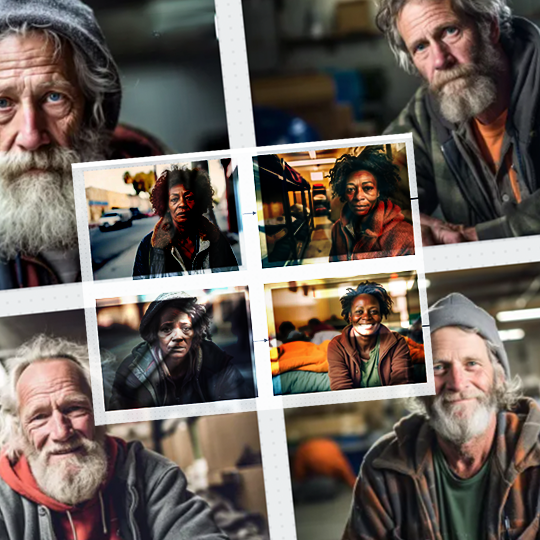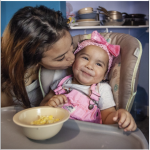Can AI fill in the gaps of traditional fundraising photography? We tested 5 experiments and here’s what we found…
From Jhovany Quiroz, Producer, Video & Storytelling
If you’re a photo enthusiast like me, you’ve probably come across the astounding AI-generated images that have been circulating lately. From the bizarre – a confused grizzly bear in calculus – to the humorous – a corgi living in a doghouse made out of sushi – and fantastical landscapes made of computer circuits, AI has reached an unprecedented peak in image generation.
While witnessing these creations has been awe-inspiring, I couldn’t help but also find them frivolous. What intrigued me more was exploring how AI-generated images could potentially enhance our nonprofit clients’ photography portfolios and bridge the gaps that traditional photography struggles to fill.
Conventional methods of building photography collections are often constrained by factors like inclement weather, limited availability of subjects, seasonal limitations and safety concerns. These variables have historically created gaps that are challenging to fill.
Getting the ideal photo can be tricky…
Gathering the ideal mix of both “need” and “joy/transformation” photos needed for a fundraising program can be quite a challenge. As the lead of BDI’s Storytellers program – which gathers photos and testimonials for use in our client partners’ fundraising appeals – my team and I have dedicated years to find creative solutions to address these gaps in our nonprofit clients’ photography archives.
- We’ve taken unconventional approaches such as asking people to wear warm jackets in the summer for cold weather shots or to appear sweaty in early spring for summer heat photos.
- We’ve sought volunteers to represent individuals on the streets, but these images often lack authenticity.
- We’ve even sent our photographers to interact with people experiencing homelessness, which isn’t always the smartest or safest choice (due to mental health, addiction struggles and other challenges) – and because of the issues surrounding privacy protection.
These approaches require extensive preparation from both clients and our Storytellers team, and the results have varied. Given these challenges, I felt compelled to explore how this new AI image-generation technology could potentially help fill the gaps I was encountering.
Here are my experiments and findings…
AI Experiment #1: Developing Specific Prompts
First, I conducted tests to ensure that the AI-generated people in the images looked and felt realistic. It took several days of fine-tuning the prompts – written instructions given to the AI tool – and creating suitable conditions for generating images that felt authentic.
All of these prompts followed a similar length with precise descriptions of technical photography settings as well as subject matter. Once I achieved the desired results, I felt ready to proceed.
AI Experiment #2: Capturing True-to-Life Struggles
Next, I attempted to create images depicting people on the street dealing with homelessness – a subject matter that is difficult to capture due to uncertainties in location, safety concerns for the photographers and privacy issues for the individuals being photographed.
AI Experiment #3: Taking Advantage of Data Seeding
Additionally, with control over these conditions, I delved into the process of “seeding” – a process that is complicated to explain briefly, but in short, allows me to set the character in different situations and alter their appearance. This newfound capability opens up possibilities for potential “Before and After” campaign photos utilizing these characters.
Why is the ability to create “before and after” photos so important for fundraising? Very often, there’s no opportunity to show the “before” part of a person’s recovery journey. While some nonprofits do capture intake photos, these often aren’t suitable for use in a typical fundraising campaign.
AI Experiment #4: Localizing by Environment
Considering that we collaborate with organizations nationwide, I wanted to ensure that I could localize the images. To accomplish this, I developed prompts that specified the desired town and state for the image generation. The AI successfully produced images that, to my eye, captured the essence of the requested locations.
AI Experiment #5: Exploring Weather Customization
Having achieved authenticity in location, I further explored photos that were specifically customized to specific weather events. I discovered that I could tailor the weather conditions to suit our needs, placing the AI-generated characters in settings featuring snow, rain, heat or even the coolness of autumn.
Final thoughts: The Visual Possibilities of AI
After several challenging, fun and frustrating months of exploration, I found the results of these tests exceeding my expectations. As a photographer and visual artist, I recognize that this tool is capable of far more than silly sushi doghouses. This tool has the ability to create content that allows its viewers to engage and see a side of life that is sometimes difficult – if not impossible – to capture.
My time exploring AI has also satisfied the questions I had about the viability to bolster our client’s photography archives. I believe a compelling case can be made for utilizing AI generated images for fundraising and nonprofit use, provided there are clear safeguards and guidelines. They are precise tools for specific projects and should only supplement the images captured during resource visits or provided by clients. Full client buy-in, transparency, consent and awareness are vital to the successful adoption of this medium.
The ability of AI to generate images that respect people’s privacy, provide BDI and our client partners with flexible and captivating visuals and ensure the safety of our photographers is a game-changer. They go beyond the superfluous creation of images for entertainment and expand a realm of possibilities that photography practitioners and enthusiasts like me have only ever dreamed of and can use to dream even bigger.
There is so much to discuss, question and dream about when it comes to using AI! Want to learn more about the possibilities and considerations of using AI generated images to fill the gaps in your nonprofit fundraising? Send me an email anytime – I’d love to talk more with you.





